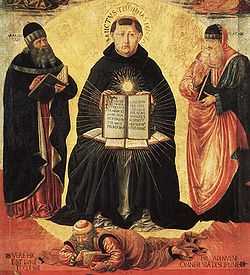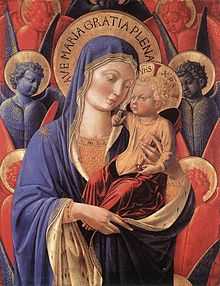Benozzo Gozzoli

Benozzo Gozzoli (c. 1421 – 1497) was an Italian Renaissance painter from Florence. He is best known for a series of murals in the Palazzo Medici-Riccardi depicting festive, vibrant processions with fine attention to detail and a pronounced International Gothic influence.
Biography
Apprenticeship
He was born Benozzo di Lese[1] in the village of Sant'Ilario a Colombano around 1421, and moved with his family, including the painters Francesco, Gerolamo, and Alesso di Benozzo, to Florence in 1427. According to Giorgio Vasari, in the early part of his career he was a pupil and assistant of Fra Angelico: some of the works in the convent of San Marco of Florence were executed by Gozzoli from Angelico's design. In 1444-1447 he collaborated with Lorenzo Ghiberti and his studio on the Paradise Doors of the Battistero di San Giovanni.
On May 23, 1447 Gozzoli was in Rome with Fra Angelico, called by Pope Eugene IV to carry out the fresco decoration of a chapel in the Vatican Palace. Later the two worked until June 1448 in the Cappella Niccolina for Nicholas V. From 1449 is a banner with Madonna and Child in the church of Santa Maria sopra Minerva, perhaps designed by Angelico. In Rome he executed also, in Santa Maria in Aracoeli, a fresco of St Anthony and Two Angels. Benozzo's last collaboration with Angelico is the vault of the Duomo di Orvieto in Umbria.
In Umbria
In 1449 he left Angelico, and moved to Umbria. From 1450 is an Annunciation in Narni, signed OPU[S] BENOT[I] DE FLORENT[IA]. In the monastery of San Fortunato, near Montefalco, he painted a Madonna and Child with Saints and Angels, and three other works. One of these, the altarpiece representing St Thomas receiving the Girdle of the Virgin, is now in the Lateran Museum and shows the affinity of Benozzo's early style to Angelico's.
He next painted in the monastery of S. Francesco, Montefalco, filling the choir chapel with three registers of episodes from the life of the St Francis of Assisi, with various accessories, including portrait heads of Dante, Petrarch and Giotto. This work was completed in 1452, and is still marked by the style of Angelico, crossed here and there with a more distinctly Giottesque influence.[2] In the same church, in the chapel of Saint Jerome, is a fresco by Gozzoli of the Virgin and Saints, the Crucifixion and other subjects.
He remained at Montefalco (with an interval at Viterbo) probably till 1456, employing Pier Antonio Mezzastris as assistant. Thence he went to Perugia, and painted in a church a Virgin and Saints that is now in the local academy.
Soon afterwards he returned to his native city Florence, the epicenter of Quattrocento art. Between 1459 and 1461, Gozzoli painted what may be considered his most important work: his frescoes of the Magi in the Magi Chapel of the Palazzo Medici-Riccardi, the Journey of the Magi to Bethlehem, and in the tribune, a composition of Angels in Paradise. Gozzoli incorporated portraits of the Medici family into his fresco The Journey of the Magi. Gozzoli also included his self-portrait in the procession, with his name written around the rim of his cap. His Virgin and Child with Saints of 1461, in the National Gallery, London, belongs also to the period of this stay in Florence.[3][4]

Late years in Tuscany
In 1464 Gozzoli left Florence for San Gimignano, where he executed some extensive works; in the church of Sant'Agostino, a composition of St. Sebastian protecting the City from the Plague of this same year, 1464; over the entire choir of the church, a triple course of scenes from the legends of St Augustine, from the time of his entering the school of Tegaste on to his burial, seventeen chief subjects, with some accessories; in the Pieve di San Gimignano, the Martyrdom of Sebastian, and other subjects, and some further works in the city and its vicinity. Here his style combined something of Filippo Lippi with its original elements, and he received co-operation from Giusto d'Andrea.
He stayed in this city till 1467, and in 1469 began the vast series of mural paintings in the Campo Santo of Pisa with which his name is specially identified. There are twenty-four subjects from the Old Testament, from the Invention of Wine by Noah to the Visit of the Queen of Sheba to Solomon. He contracted to paint three subjects per year for about ten ducats each. It appears, however, that this contract was not strictly adhered to, for the actual rate of painting was only three pictures in two years. Perhaps the great multitude of figures and accessories was accepted as a set-off against the slower rate of production.
By January 1470 he had executed the fresco of Noah and his Family, followed by the Curse of Ham, the Building of the Tower of Babel (which contains portraits of Cosimo de' Medici, the young Lorenzo, Angelo Poliziano and others), the Destruction of Sodom, the Victory of Abraham, the Marriages of Rebecca and of Rachel, the Life of Moses, etc. In the Cappella Ammannati, facing a gate of the Campo Santo, he painted also an Adoration of the Magi, wherein appears a portrait of himself.

All this enormous mass of work, in which Benozzo was probably assisted by Zanobi Macchiavelli, was performed, in addition to several other pictures during his stay in Pisa (including the Glory of St. Thomas Aquinas, now in the Louvre), in sixteen years, lasting up to 1485. This is the latest date which can with certainty be assigned to any work from his hand. Gozzoli died in Pistoia in 1497, perhaps of a pestilence.
In 1478 the Pisan authorities had given him, as a token of their regard, a tomb in the Campo Santo. He had likewise a house of his own in Pisa, and houses and land in Florence.[3]
Evaluation
According to the 1911 Encyclopædia Britannica :
The art of Gozzoli does not rival that of his greatest contemporaries, either in elevation or in strength, but is pre-eminently attractive by its sense of what is rich, winning, lively and abundant in the aspects of men and things. His landscapes, thronged with birds and quadrupeds, especially dogs, are more varied, circumstantial and alluring than those of any predecessor; his compositions are crowded with figures, more characteristically true when happily and gracefully occupied than when the demands of the subject require tragic or dramatic intensity, or turmoil of action; his colour is bright, vivacious and festive. Gozzoli's genius was, on the whole, more versatile and assimilative than vigorously original; his drawings not free from considerable imperfections, especially in the extremities and articulations, and in the perspective of his gorgeously-schemed buildings. In fresco-painting he used the methods of tempera, and the decay of his works has been severe in proportion. Of his untiring industry, the recital of his labours and the number of works produced are the most convincing attestation... In rectitude of life he is said to have been worthy of his first master, Fra Angelico.
Major works

- The Rape of Helen (c. 1437-1439) - Tempera on panel, 51 x 61 cm, National Gallery, London
- Women at the Tomb (1440-1441) - Fresco, San Marco, Florence
- Adoration of the Magi (1440-1441) - Fresco, San Marco, Florence
- Madonna and Child Giving Blessings (1449) - Tempera on silk on a wooden mount, 254 x 130 cm, Santa Maria sopra Minerva, Rome
- Madonna and Child between St Francis and St Bernardine of Siena (1450) - Fresco, San Fortunato, Montefalco
- St Fortunatus Enthroned (1450) - Fresco, 200 x 110 cm, San Fortunato, Montefalco
- Madonna and Child (1450) - Fresco, 250 x 135 cm, San Fortunato, Montefalco
- St. Anthony of Padua (1450s) - Panel, Santa Maria in Aracoeli, Rome
- Madonna della Cintola (1450) - Tempera on panel, 133 x 165 cm, Pinacoteca Vaticana, Vatican
- Madonna and Child Surrounded by Saints (1452) - Fresco, San Francesco, Cappella di San Gerolamo, Montefalco
- The Departure of St Jerome from Antioch (1452) - Fresco, Cappella di San Gerolamo, San Francesco, Montefalco
- St Jerome Pulling a Thorn from a Lion's Paw (1452) - Fresco, Cappella di San Gerolamo, San Francesco, Montefalco
- Madonna and Child with Sts Francis and Bernardine, and Fra Jacopo (c. 1452) - Tempera on panel, 34 x 54 cm, Kunsthistorisches Museum, Vienna
- Madonna and Child with Sts John the Baptist, Peter, Jerome, and Paul (1456) - Tempera on panel, 122 x 212 cm, Galleria Nazionale dell'Umbria, Perugia
- Procession of the Magi (1459–1460) - Frescoes, Magi Chapel, Palazzo Medici Riccardi, Florence
- Madonna and Child (c. 1460) - Tempera on panel, 84.8 x 50.6 cm, Detroit Institute of Arts, Detroit
- Purification Altarpiece (1461) - Tempera on panel, 158 x 171 cm, National Gallery, London
- St. Dominic Reuscitates Napoleone Orsini (1461) - Tempera on panel, 25 x 35 cm, Pinacoteca di Brera, Milan
- Fall of Simon Magus (1461-1462) - Tempera on panel, 24 x 35,5 cm, Royal Collection, Hampton Court
- The Dance of Salome (1461-1462) - Tempera on panel, 23.8 x 34.3 cm, National Gallery of Art, Washington
- Histories of St. Augustine (1464–1465) - Frescoes, Sant'Agostino, San Gimignano
- Four Evangelists (1464–1465) - Fresco, Sant'Agostino, San Gimignano
- Saints (1464–1465) - Frescoes, Sant'Agostino, San Gimignano
- St. Sebastian Intercessor (1464–1466) - Fresco, 527 x 248 cm, Sant'Agostino, San Gimignano
- Martyrdom of St Sebastian (1465) - Tempera on panel, 525 x 378 cm, Collegiate Church, San Gimignano
- Mystical Marriage of St. Catherine (1466) - Tempera on panel, 90 x 50 cm, Pinacoteca Comunale, Terni
- Madonna and Child between Sts. Andrew and Prosper (Madonna dell'Umiltà; 1466) - Tempera on panel, 137 x 138 cm, Museo Civico, San Gimignano
- Triumph of St. Thomas Aquinas (1471) - Tempera on panel, 230 x 102 cm, Musée du Louvre, Paris
- The Vintage and Drunkenness of Noah (1469-1484) - Fresco, Camposanto, Pisa
- Histories of the Holy Virgin (1484) - Transferred frescoes, Biblioteca Comunale, Castelfiorentino
- Descent from the Cross (1491) - Oil on canvas, 180 x 300 cm, Museo Horne, Florence
Notes
- ↑ The nickname "Gozzoli" does not appear in any documents; Giorgio Vasari recorded it in his second edition of the Vite (1568).
- ↑ History of the chapel of the Choir of San Francesco, and its frescoes with depictions and descriptions of all the scenes.
- ↑ 3.0 3.1
 One or more of the preceding sentences incorporates text from a publication now in the public domain: Chisholm, Hugh, ed. (1911). "Gozzoli, Benozzo". Encyclopædia Britannica 12 (11th ed.). Cambridge University Press. This has additional references:
One or more of the preceding sentences incorporates text from a publication now in the public domain: Chisholm, Hugh, ed. (1911). "Gozzoli, Benozzo". Encyclopædia Britannica 12 (11th ed.). Cambridge University Press. This has additional references:
- Vasari, Crowe and Cavalcaselle, and the other ordinary authorities, can be consulted as to the career of Gozzoli.
- A separate Life of him, by H. Stokes, was published in 1903 in Newne’s Art library.
- ↑ Another small picture in the same gallery, the Rape of Helen, is of dubious authenticity (Chisholm, 1911).
References
- Dale Kent, Cosimo de' Medici and the Florentine Renaissance (New Haven: Yale University Press, 2000).
- Franco Cardini, The Chapel of the Magi in Palazzo Medici (Firenze: Mandragora, 2001).
- Roger J. Crum, "Roberto Martelli, the Council of Florence, and the Medici Palace Chapel", Zeitschrift & Kunstgeschichte, 59 (1996).
| Wikimedia Commons has media related to Benozzo Gozzoli. |
External links
| Wikisource has original text related to this article: |
- Web Gallery of Art
- Olga's Gallery
- Life of St. Augustine Frescoes with Narrative Explanation
- BEGO - Benozzo Gozzoli Museum
|
